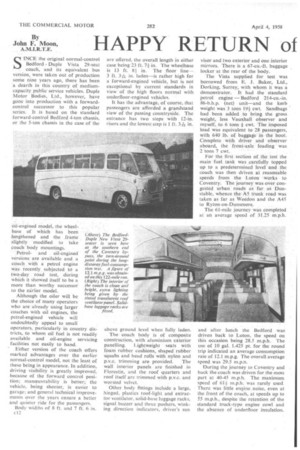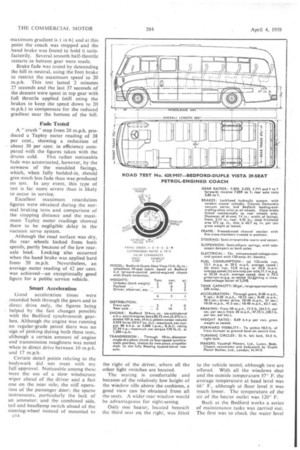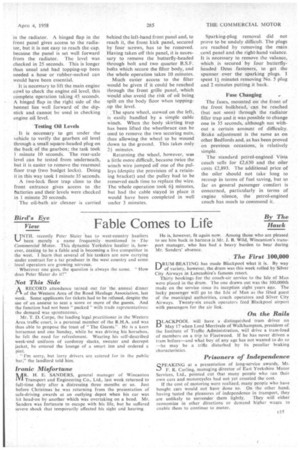HAPPY RETURN of the VISTA
Page 50

Page 51

Page 52

Page 53

If you've noticed an error in this article please click here to report it so we can fix it.
By John F. Moon,
A.M.I.R.T.E.
SINCE the original normal-control Bedford Duple Vista 29-seat . coach, and its equivalent bus version, were taken out of production some nine years ago, there has been -a dearth in this country of mediumcapacity public service vehicles. Duple Motor Bodies, Ltd., however, have gone into production with a forwardcontrol successor to this popular series. It is based on the standard forward-control Bedford 4-ton chassis, or the 5-ton chassis in the case of the
Oil-engined model, the wheelbase of which has been lengthened and the frame slightly modified to take coach body mountings.
Petroland oil-engined versions are available and a coach _ with a petrol engine was recently, subjected to a two-day road test, duringwhich it showed itself to be a more than worthy successor to the ed.rlier model.
Although the oiler will be the choice of many operators who are already using larger coaches with oil engines, the petrol-engined vehicle will undoubtedly appeal to small operators, particularly in country districts,, to whom oil fuel is not readily available and oil-engine servicing facilities not easily to hand.
Either version of the coach offers marked advantages over the earlier normal-control model, not the least of these being in appearance. In addition, driving visibility is greatly improved, because of the forward control positiOn; manceuvrability is better; the vehicle, being shorter, is easier to garage; and general technical improvements over the years ensure a better and quieter ride for the passengers.
Body widths of S ft. and 7 ft. 6 in. are offered, the overall length in either case being 23 ft. 7+ in. The wheelbase is 13 ft. 8+ in. The floor line3 ft. 3; in. laden—is rather high for a forward-engined vehicle, but is not exceptional by current standards in view of the high floors normal with underfloor-engined vehicles.
It has the advantage, of course, that passengers are afforded a grandstand view of the passing countryside. The entrance has two steps with 12-in.
risers and the lowest step is 1 ft. 3 in.
above ground level when fully laden.
The coach body is of composite construction, with aluminium exterior panelling. Lightweight seats with foam rubber cushions, shaped rubber squabs and head rolls with nylon and p.v.c. trimming are provided. The wall interior panels are finished in Florestin, and the roof quarters and roof itself are trimmed with p.v.c. and worsted velvet.
Other body fittings include a large, hinged, plastics roof-light and extractor ventilator, solid-base luggage racks, signal buzzer and three pushers, winking direction indicators, driver's sun visor and two exterior and one interior mirrors. There is a 67-cu.-ft. baggage locker at the rear of the body.
The Vista supplied for test was borrowed from E. J. Baker, Ltd., Dorking, Surrey, with whom it was a demonstrator. It had the standard petrol engine — Bedford 214-cu.-in. 86-b.h.p. (net) unit—and the kerb weight was 3 tons 19+ cwt. Sandbags had been added to bring the gross weight, less Vauxhall observer and myself, to .6 tons cwt. The imposed lOad was equivalent to 28 passengers, with 640 lb. of baggage in the boot. Complete with driver and observer aboard, the front-axle loading was 2 tons 7 cwt.
For the first section of the test the main fuel tank was carefully topped up to a predetermined level and the coach was then driven at reasonable speeds from the Luton works to Coventry. The journey was over congested urban roads as far as Dunstable, whence the A5 trunk road was taken as far as Weedon and the A45 to Ryton-on-Dunsmore.
The 61-mile journey was completed at an average speed of 31.25 m.p.h.
and after lunch the Bedford was driven back to Luton, the speed on this occasion being 28.5 m.p.h. The use of 10 gal. 1.425 pt. for the round trip indicated an average consumption rate of 12.1 m.p.g. The overall average speed was 29.5 m.p.n.
During the journey to Coventry and back the coach was driven for the most part at 40-45 m.p.h. The maximum speed of 61+ m.p.h. was rarely used. There was little engine.noise, even at the front of the coach, at speeds up to 55 m.p.h., despite the retention of the standard truck-type engine cowl and the absence of underfloor insulation. Unfortunately, gear whine in the indirect ratios was little less than that associated with the earlier Vista, but other than an occasional noise from the centre bearing when on the overrun, the transmission was quiet when running in top gear.
The coach handled splendidly, the steering being positive and without the slight sense of wander normally associated with Bedford steering layouts because of the small castor action. The lightness of the steering was partizularly advantageous when manceuvring in thick traffic, as, combined with the good forward visibility, it was possible to dodge in and out in a way more normally associated with small cars.
Considering that standard 4-ton truck springs are used on the chassis, plus telescopic dampers on both axles (these are standard at the front, in any case), the suspension of the coach was surprisingly good. It was a bit hard at the rear, but it was by no means uncomfortable.
Drivers will be quick to appreciate the small, positive movement of the gear lever, whilst the pedals are light in operation. Although the top-gear performance of the coach is reasonably satisfactory at normal cruising speeds, it falls off sharply below 25 m.p.h. Third gear is, however, sufficient for most main-road hills and
• gives lively acceleration in towns. It gives a quick get-away between 10 m.p.h. and 35 m.p.h.
After the long-distance consumption run a series of shortdistance tests was conducted over a six-mile undulating course between Barton and Clophill. Conditions were not good, the roads being covered with hard-packed snow, in contrast to the dry, sunny weather of the previous day.
The first of the short runs was made non-stop at an average speed of 32.8 m.p.h. and a consumption rate of 12.8 m.p.g. A second run, making one stop per mile, gave a fuel return of 11.1 m.p.g.; the average speed (based on the time the wheels were turning) was 25.25 m.p.h.
Next the coach was taken up Bison Hill, where a fast climb was made in 31 minutes, bottom" gear being required for 11 minutes. The ambient temperature during the ascent was 31.5° F. and the temperature of the engine coolant measured at the radiator header tank rose from 146° F. to 155° F.
Even at the higher temperature the thermostat in the cooling system would not be fully opened and, allowing for the fact that the system is pressurized to raise the boiling point, overheating should never occur, no matter what the conditions.
Bison Hill is mile long and has an average gradient of I in 104. Its , c13 maximum gradient is 1 in 61 and at this point the coach was stopped and the hand brake was found to hold it satisfactorily. Several smooth half-throttle restarts in bottom gear were made.
Brake fade was tested by descending the hill in neutral, using the foot brake to restrict the maximum speed to 20 m.p.h. This test lasted 2 minutes 27 seconds and the last 37 seconds of the descent were spent in top gear with full throttle applied (still using the brakes to keep the speed down to 20 m.p.h.) to compensate for the reduced gradient near the bottom of the hill.
Fade Tested A " crash " stop from 20 m.p.h. produced a Tapley meter reading of 38 per cent., showing a reduction of about 30 per cent. in efficiency compared with the figures taken with the
drums cold. This rather noticeable fade was accentuated, however, by the newness of the moulded facings, which, when fully bedded-in, should give much less fade than was produced on test. in any event, this type of test is far more severe than is likely to occur in service.
Excellent maximum retardation figures were obtained during the normal braking tests and comparison of the stopping distance and the maximum Tapley meter readings showed there to be negligible delay in the vacuum servo system.
Although the road surface was dry, the rear wheels locked from both speeds, partly because of the low rearaxle load. Locking also occurred when the hand brake was applied hard from 20 m.p.h. Nevertheless, an average meter reading of 42 per cent. was achieved—an exceptionally good figure for a public service vehicle.
Smart Acceleration Good acceleration times were recorded both through the gears and in direct drive only, the figures being helped by the fast changes possible with the Bedford synchromesh gearbox. Although the engine was running on regular-grade petrol there was no sign of pinking during both these tests, although a certain amount of engine and transmission roughness was noted when in direct drive between 10 m.p.h. and 17 m.p.h.
Certain detail points relating to the bodywork did not meet with my full approval. Noticeable among these were the use of a slow windscreen wiper ahead of the driver and a fast one on the near side; the stiff operation of the passenger door; the sparse instruments, particularly the lack of an ammeter; and the combined side, tail and headlamp switch ahead of the steering-wheel instead of mounted to c14
the right of the driver, where all the other light switches are located.
The seating is comfortable and because of the relatively low height of the window sills above the cushions, a good view can be obtained from all the seats. A wider rear window would be advantageous for sight-seeing.
Only one heater, located beneath the third seat on the right, was fitted
to the vehicle tested, although two are offered. With all the windows shut and the outside temperature 37° F. the average temperature at head level was 66 F., although at floor level it was much lower. The temperature of the air of the heater outlet was 120° F.
Back at the Bedford works a series of maintenance tasks was carried out. The first was to check the water level
in the radiator. A hinged flap in the front panel gives access to the radiator, but it is not easy to reach the cap, because the panel is set well forward from the radiator. The level was checked in 25 seconds. This is longer than usual and had topping-up been needed a hose or rubber-necked can would have been essential.
It is necessary to lift the main engine cowl to check the engine oil level, this complete operation taking 45 seconds, A hinged flap in the right side of the bonnet lies well forward of the dipstick and cannot be used in checking engine oil level.
Testing Oil Levels It is necessary to get under the vehicle to verify the gearbox oil level through a small square-headed plug on the back of the gearbox; the task took 1 minute 10 seconds, The rear-axle level can be tested from underneath, but it is easier to remove the rearmost floor trap (two budget locks). Doing it in this way took 1 minute 35 seconds.
A two-lock floor trap close to the front entrance gives access to the batteries and their levels were checked in 1 minute 20 seconds.
The oil-bath air cleaner is carried
behind the left-hand front panel and, to reach it, the front kick panel, secured by four screws, has to be removed. Having taken off this panel, it is necessary to remove the butterfly-headed through bolt and two quarter B.S.F. bolts which secure the fitter body, and the whole operation takes 10 minutes.
Much easier access to the filter would be given if it could be reached through the front grille panel, 'which would also avoid the risk of oil being spilt on the body floor when toppingup the level.
The spare wheel, stowed on the left, is easily handled by a simple cable winch. When the body skirting trap has been lifted the wheelbrace can be used to remove the two securing nuts, thus allowing the wheel to be wound down to the ground. This takes only 21 minutes.
Returning the wheel, however, was a little more difficult, because twice the winch wire jumped off one of the pulleys (despite the provision of a retaining bracket) and the pulley had to be removed each time to replace the wire. The whole operation took 64 minutes, but had the cable stayed in place it would have been completed in well under 3 minutes. Sparking-plug removal did not prove to be unduly difficult. The plugs are reached by removing the main cowl panel and the right-hand valance. It is necessary to remove the valance, which is secured. by four butterflyheaded Dzus fasteners, to get the spanner over the sparking plugs. I spent 14minute S removing No. 5 plug and 2 minutes putting it back.
Fuse Changing
The fuses, mounted on the front of the front bulkhead, can be reached (but not seen) through the radiator filler trap and it was possible to change one in 35 seconds, although not without a certain amount of difficulty. Brake adjustment is the same as on other Bedfords and, as has been proved on previous occasions, is relatively sim pie.
The standard petrol-engined Vista coach sells for £2,630 and the oiler costs £2,893. The additional price of the oiler should not take long to recoup in terms of fuel saving, but so far as general passenger comfort is concerned, particularly in terms of engine silence, the petrol-engined coach has much to commend it.












































































































